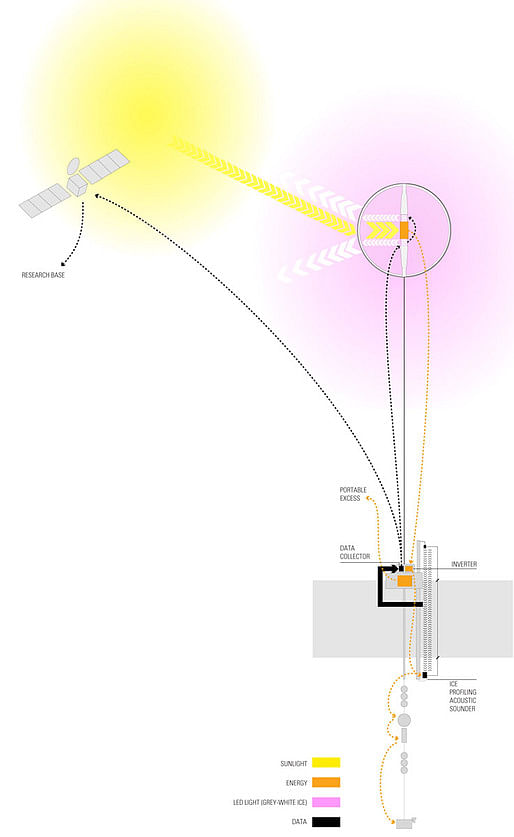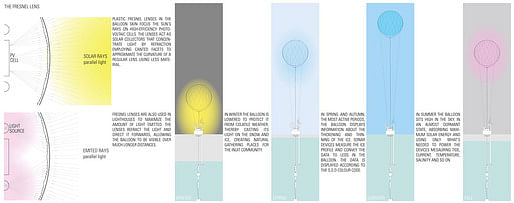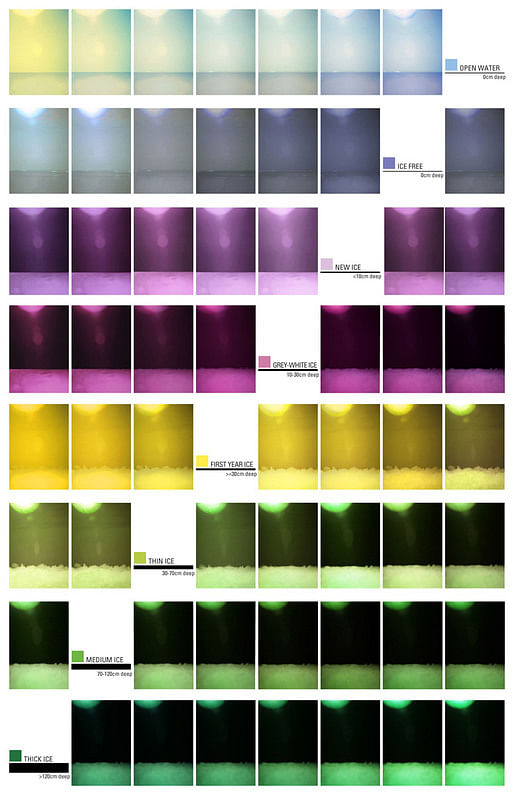

In anticipation of this week's event, Publish Or... bracket [GOES SOFT], we will be showcasing a piece from the book each day this week. We hope to see you this Thursday!
Buoyant Light
by Claire Lubell and Virginia Fernandez
The Canadian Arctic is a vast landscape, dotted with remote communities whose lives depend on natural cycles for subsistence. While imagining widespread distribution, Buoyant Light is sited in Igloolik, an Inuit community of 1600 at 70 degrees North with active creative and research programs. Like much of the Arctic, Igloolik is witness to acute changes in permafrost, sea levels and ice. As an island, it is particularly vulnerable to unreliable freeze-thaw cycles of the sea which directly affects safe hunting and traveling.

Image: View of Igloolik at night, illuminated on land and water by a distributed series of buoyant lights.
Buoyant Light consists of a balloon and a buoy which serve a dual function: to harvest solar energy, providing Igloolik with light in the long winter; and to make data visually accessible to the community. The proposal leverages the needs of global researchers with those of the Inuit by providing an interface between the information collected and the people most directly affected by it. Furthermore, this interface introduces colour as a new seasonal cycle into the Arctic and scatters light in the landscape.

Image: A cluster activates the space outside the Northern Store while also measuring changes in permafrost around building foundations. New street lighting improves safety at night.
Solar balloons are paired with buoys, used by researchers to gather data on tides, currents, temperature, salinity, sedimentation and ice profile. Surplus energy collected is kept in portable batteries in the buoy while a small portion of the energy is used to power the buoy’s mechanism and the LED lights in the balloon. Information regarding sea ice profile, already colour coded according to an international standard, is transmitted to the balloon via fiber optics and communicated through the corresponding colour.

Image: Community members gather on the ice on a winter night to watch the youth of Artcirq perform.
Buoyant Light addresses three different needs: the largest balloons are closest to the shore and provide the community with immediate visual access to information. Acting as a traditional lighthouse, they mark the location of the town for approaching travelers and vessels. Lowered in the winter to protect them from higher winds and more frequent storms, the balloons cast light onto the ice, forming a space for meetings, celebrations or performances. The balloons further out in the open waters, act as way-finding devices for hunters and travelers. Once distributed throughout Arctic waters, they act as a soft network connecting remote communities, while also providing widespread data collection points for international researchers.

Image: The visual impact of the balloon begins to disappear in spring. Fisherman can access the equipment for maintenance checks after the long winter.
Finally, the balloons on land delineate gathering spaces around key buildings in the town. A few clusters measure the change in permafrost detrimental to the structural stability of buildings. In arctic communities where there is little urban framework or strategy for growth, the project helps to demarcate community spaces and suggest nodes of activity. Over time, smaller solar balloons could be used to provide a new sustainable lighting solution for Arctic communities, improving energy consumption costs and the safety of inhabitants.

Image: Site climate research
Buoyant Light frames light as a constant in the rapidly changing Arctic climate where the solar path has become a datum against which to track changes in other seasonal cycles. Recognizing that in this fragile environment any physical changes can have powerful implications, the project proposes an almost ethereal intervention that would improve the life of the Inuit through light.

Image: Plan and elevation
Technical Specifications:
Buoyant Light combines various existing technologies: research buoys, lighting balloons and photovoltaics to create a more intelligent monitoring and communication instrument in the Arctic.

Image: Detailed section
A multipurpose research buoy is supplemented with an additional battery and a remote controller for the LED lights. Information collected by the ice profiling sonar device in the buoy is conveyed via a fiber optic cable to the LEDs, programmed according the international ice development colour code. The LEDS and PV cells are mounted on a shock absorption frame to counter any deformation due to movement or pressure and temperature fluctuation.

Image: Process diagram
The standard dimensions of the buoy range between 1.5 meter diameter and 3 meters. Whereas the solar balloons varies from 0.5 meter diameter for those used as street lighting, to 3 meters for those used close to the shore, to 5 meters for those distributed along hunting paths and throughout arctic waters. The balloon is lashed to the buoy in the same way hot air balloons are to their basket. A nylon mesh adhered to the balloon’s skin and tied to multiple high strength nylon cords attached to the buoy.

Image: Fresnel lens seasons diagram
The balloon consists of two layers, an inner transparent plastic bladder filled with a lighter-than-air gas, and a pre-moulded 3mm thick shell made of ETFE polymer plastic with fiberglass reinforcing to provide some rigidity and greater durability. The outer surface is smooth while the inner is ribbed. The ribbing creates facets which replicate the effects of a fresnel lens, focusing incoming light to increase solar absorption, and dispersing outgoing light to maximize the emitted colour light from the LEDs. The Fresnel Lens was developed in the late 1800s to improve the visibility of lighthouses.

Image: The color code
All the components should be manufactured off site to ensure quality control and cost effectiveness, but given the remoteness of the site, the equipment must allow assembly and repair on location. Furthermore, specific knowledge should be developed within the community for general and seasonal maintenance.
Claire Lubell and Virginia Fernandez recently completed their undergraduate studies at the University of Waterloo, School of Architecture.
No Comments
Block this user
Are you sure you want to block this user and hide all related comments throughout the site?
Archinect
This is your first comment on Archinect. Your comment will be visible once approved.